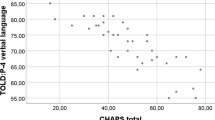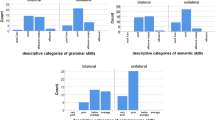Abstract
Objectives
This study aims to evaluate the relationship between phoneme recognition skills and language development skills in pediatric auditory brainstem implant (ABI) users. It further intends to identify the delays and problems that may occur in the phoneme recognition skills of children with ABI and shed light on rehabilitation programs.
Methods
Our study included 20 children using ABI and another 20 using cochlear implants (CI). They were aged between 6 and 8 years 11 months. The participants exhibited homogenous demographic and audiological characteristics. The Turkish version of the Test of Language Development-Primary: Fourth Edition (TOLDP:4) was used to evaluate the language development skills, and the Turkish version of the Phoneme Recognition Test (PRT) was applied to assess the phoneme recognition skills.
Results
There was a statistically significant difference (p < 0.05) in the PRT values as well as in the language development skills between the children with ABI and those with CI. It was observed that the values of the children with CI were significantly higher than those of children with ABI.
Conclusion
Although children with ABI were not able to match the skills of their peers with CI, their language development and communication skills improved. It is believed that this study will contribute to the literature by demonstrating that the use of ABI improves phoneme recognition skills in children who are not eligible for CI or who do not adequately benefit from CI.


Similar content being viewed by others
References
Yang J, Li P (2019) Mechanisms for auditory perception: a neurocognitive study of second language learning of Mandarin Chinese. Brain Sci 9(6):139
Cumming R, Wilson A, Goswami U (2015) Basic auditory processing and sensitivity to prosodic structure in children with specific language impairments: a new look at a perceptual hypothesis. Front Psychol 6:972
Bertoncini J, Serniclaes W, Lorenzi C (2009) Discrimination of speech sounds based upon temporal envelope versus fine structure cues in 5-to 7-year-old children. J Speech Lang Hear Res 52(3):682–695
Bharadwaj HM (2014) Individual differences in supra-threshold auditory perception-mechanisms and objective correlates. Boston University
Anthony JL, Francis DJ (2005) Development of phonological awareness. Curr Dir Psychol Sci 14(5):255–259
Blachman BA (1994) What we have learned from longitudinal studies of phonological processing and reading, and some unanswered questions: a response to Torgesen, Wagner, and Rashotte. J Learn Disabil 27(5):287–291
Gillon GT (2017) Phonological awareness: from research to practice. Guilford Publications
Lund E (2020) The relation between vocabulary knowledge and phonological awareness in children with cochlear implants. J Speech Lang Hear Res 63(7):2386–2402
Anthony JL, Lonigan CJ (2004) The nature of phonological awareness: converging evidence from four studies of preschool and early grade school children. J Educ Psychol 96(1):43
Soleymani Z, Mahmoodabadi N, Nouri MM (2016) Language skills and phonological awareness in children with cochlear implants and normal hearing. Int J Pediatr Otorhinolaryngol 83:16–21
Davidson LS, Geers AE, Hale S, Sommers MM, Brenner C, Spehar B (2019) Effects of early auditory deprivation on working memory and reasoning abilities in verbal and visuospatial domains for pediatric cochlear implant recipients. Ear Hear 40(3):517–528
Gravenstede L (2009) Phonological awareness and decoding skills in deaf adolescents. Deaf Educ Int 11(4):171–190
McGill-Franzen A (2010) The national early literacy panel report: summary, commentary, and reflections on policies and practices to improve children’s early literacy: guest editor’s introduction. Educ Res 39(4):275–278
Mellon N (2009) Language and speech acquisition. cochlear implants principles and practices. Lippincot Williams & Wilkins, London
Sennaroğlu L, Colletti V, Lenarz T, Manrique M, Laszig R, Rask-Andersen H, Göksu N, Offeciers E, Saeed S, Behr R (2016) Consensus statement: long-term results of ABI in children with complex inner ear malformations and decision making between CI and ABI. Cochlear Implants Int 17(4):163–171
Sennaroglu L, Sennaroglu G, Yücel E, Bilginer B, Atay G, Bajin MD, Mocan BÖ, Yaral M, Aslan F, Çnar BÇ (2016) Long-term results of ABI in children with severe inner ear malformations. Otol Neurotol 37(7):865–872
Yoshinaga-Itano C (2003) Early intervention after universal neonatal hearing screening: impact on outcomes. Ment Retard Dev Disabil Res Rev 9(4):252–266
Long CJ, Nimmo-Smith I, Baguley DM, O’Driscoll M, Ramsden R, Otto SR, Axon PR, Carlyon RP (2005) Optimizing the clinical fit of auditory brain stem implants. Ear Hear 26(3):251–262
Wong K, Kozin ED, Kanumuri VV, Vachicouras N, Miller J, Lacour S, Brown MC, Lee DJ (2019) Auditory brainstem implants: recent progress and future perspectives. Front Neurosci 13:10
Faes J (2020) Gillis S (2020) Word characteristics and speech production accuracy in children with auditory brainstem implants: a longitudinal triple case report. Clinical Linguist Phon 10(1080/02699206):1838613
Colletti V, Carner M, Fiorino F, Sacchetto L, Miorelli V, Orsi A, Cilurzo F, Pacini L (2002) Hearing restoration with auditory brainstem implant in three children with cochlear nerve aplasia. Otol Neurotol 23(5):682–693
van der Straaten TF, Netten AP, Boermans PPB, Briaire JJ, Scholing E, Koot RW, Malessy MJ, van der Mey AG, Verbist BM, Frijns JH (2019) Pediatric auditory brainstem implant users compared with cochlear implant users with additional disabilities. Otol Neurotol 40(7):936–945
Niparko JK, Tobey EA, Thal DJ, Eisenberg LS, Wang N-Y, Quittner AL, Fink NE, Team CI (2010) Spoken language development in children following cochlear implantation. JAMA 303(15):1498–1506
Geers A, Brenner C, Davidson L (2003) Factors associated with development of speech perception skills in children implanted by age five. Ear Hear 24(1):24S-35S
Tobey EA, Thal D, Niparko JK, Eisenberg LS, Quittner AL, Wang N-Y, Team CI (2013) Influence of implantation age on school-age language performance in pediatric cochlear implant users. Int J Audiol 52(4):219–229
Aslan F, Ozkan HB, Yücel E, Sennaroglu G, Bilginer B, Sennaroglu L (2020) Effects of age at auditory brainstem implantation: impact on auditory perception, language development. Speech Intelligibility Otol Neurotol 41(1):11–20
Svirsky MA, Robbins AM, Kirk KI, Pisoni DB, Miyamoto RT (2000) Language development in profoundly deaf children with cochlear implants. Psychol Sci 11(2):153–158
Yucel E, Aslan F, Ozkan HB, Sennaroglu L (2015) Recent rehabilitation experience with pediatric ABI users. J Int Adv Otol 11(2):110–113
Newcomer PL, Hammill DD (2008) TOLD-P: 4: test of language development. Primary. Pro-Ed Austin, TX
Topbaş S, Güven O (2017) Türkçe Okulçağı Dil Gelişimi Testi-TODİL. Test Bataryası
Katz J, Chasin M, English KM, Hood LJ, Tillery KL (1978) Handbook of clinical audiology, vol 428. Williams & Wilkins Baltimore
Küçükünal I (2012) Konuşma sesleri tanıma testi (kstt) Türkçe geçerlik güvenirlik çalışması. Yüksek Lisans Tezi. Ankara: Hacettepe Üniversitesi
Colletti L, Shannon RV, Colletti V (2014) The development of auditory perception in children after auditory brainstem implantation. Audiol Neurotol 19(6):386–394
Nevison B, Laszig R, Sollmann W-P, Lenarz T, Sterkers O, Ramsden R, Fraysse B, Manrique M, Rask-Andersen H, Garcia-Ibanez E (2002) Results from a European clinical investigation of the Nucleus® multichannel auditory brainstem implant. Ear Hear 23(3):170–183
Eisenberg LS, Johnson KC, Martinez AS, DesJardin JL, Stika CJ, Dzubak D, Mahalak ML, Rector EP (2008) Comprehensive evaluation of a child with an auditory brainstem implant. Otol Neurotol 29(2):251–257
Colletti V, Shannon RV (2005) Open set speech perception with auditory brainstem implant? Laryngoscope 115(11):1974–1978
Bayazıt YA, Kosaner J, Cicek Cınar B, Atac A, Tutar H, Gunduz B, Altinyay S, Gokdogan C, Ant A, Ozdek A (2014) Methods and preliminary outcomes of pediatric auditory brainstem implantation. Ann Otol Rhinol Laryngol 123(8):529–536
Colletti L, Zoccante L (2008) Nonverbal cognitive abilities and auditory performance in children fitted with auditory brainstem implants: preliminary report. Laryngoscope 118(8):1443–1448
Dunn CC, Tyler RS, Oakley S, Gantz BJ, Noble W (2008) Comparison of speech recognition and localization performance in bilateral and unilateral cochlear implant users matched on duration of deafness and age at implantation. Ear Hear 29(3):352
Goupell MJ, Cosentino S, Stakhovskaya OA, Bernstein JG (2019) Interaural pitch-discrimination range effects for bilateral and single-sided-deafness cochlear-implant users. J Assoc Res Otolaryngol 20(2):187–203
Yüksel M, Meredith MA, Rubinstein JT (2019) Effects of low frequency residual hearing on music perception and psychoacoustic abilities in pediatric cochlear implant recipients. Front Neurosci 13:924
Sung JKK, Luk BPK, Wong TKC, Thong JF, Wong HT, Tong MCF (2018) Pediatric auditory brainstem implantation: impact on audiological rehabilitation and tonal language development. Audiol Neurotol 23(2):126–134
Batuk MO, Cinar BC, Yarali M, Aslan F, Ozkan HB, Sennaroglu G, Yucel E, Bajin MD, Bilginer B, Sennaroglu L (2020) Bimodal stimulation in children with inner ear malformation: one side cochlear implant and contralateral auditory brainstem implant. Clin Otolaryngol 45(2):231–238
Ashori M, Yazdanipour M, Pahlavani M (2019) The effectiveness of cognitive rehabilitation program on auditory perception and verbal intelligibility of deaf children. Am J Otolaryngol 40(5):724–728
DesJardin JL, Eisenberg LS (2007) Maternal contributions: Supporting language development in young children with cochlear implants. Ear Hear 28(4):456–469
Author information
Authors and Affiliations
Corresponding author
Ethics declarations
Ethical approval
Ethics Committee of Ankara Yildirim Beyazit University approved this study with the date and decision number 16.10.2019/80.
Additional information
Publisher's Note
Springer Nature remains neutral with regard to jurisdictional claims in published maps and institutional affiliations.
Rights and permissions
About this article
Cite this article
Baş, B., Yücel, E. Evaluation of phoneme recognition skills in pediatric auditory brainstem implant users. Eur Arch Otorhinolaryngol 279, 1741–1749 (2022). https://doi.org/10.1007/s00405-021-06840-3
Received:
Accepted:
Published:
Issue Date:
DOI: https://doi.org/10.1007/s00405-021-06840-3




